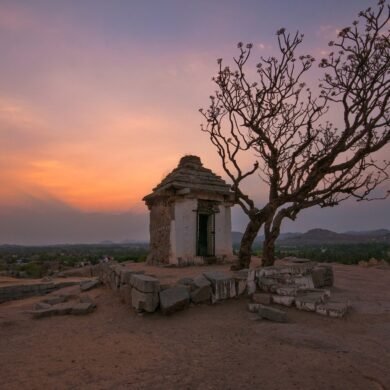The Stepped Tank, also known as Pushkaranis in Hampi are water tanks that are attached to temples, They are also called by names like irtha, Kalyani, pushkarni, pukhuri, Talab, etc in different languages and regions of the country. Earlier in India, the temples had water reservoirs near them which they used for cleaning or washing the temples. Some of the temples even had large stepped tanks and ponds for devotees to shower their devotion.
The locals here claim that some of the tanks here are said to be magical and cure any disease after one takes a dip in it. Various rituals were performed in these sacred tanks of Hampi. Even today, The Stepped Tank in Hampi is a prominent location and a primary attraction for the tourists who visit Hampi to explore the ruins of the Vijayanagara Empire.
History Of The Stepped Tank
The Stepped Tank was discovered by The Archaeological Survey Of India during an excavation in 1984-85, the beautiful tank was completely under the surface of the soil and was not at all visible from the outer surface before the excavation. As the temples were an important part of the social and cultural lives of the people in ancient Hampi.
The Stepped Tank also gained significance among the people. Every year the water tanks were used as the venue for the annual boat festivals, the images of the gods and goddesses were taken out from the temples during the time for a coracle ride on the water tanks.
Though the rest of the palace was all destroyed by invading rulers, this place is all intact. There are some water tanks that are not related to the temples and few large water tanks as well that were created for the use of the general public and some of the main water tanks are situated within the Royal Enclosure which was specially built for the members of the Royal Family of the Vijayanagara Empire. This tank is very ornate and is considered as one of the most beautiful monuments of Hampi.
Architecture Of The Stepped Tank
The Stepped Tank was built using finely finished blocks of black schist stone, Every steps or stone bear some sketches or marks made by the architects, The main purpose of the tank is unknown, but it was mostly used for religious ceremonies by the royals and also used for immersing of Ganesha idols during the Hindu festivals.
There are mason marks and individual blocks which indicate the direction of the flow of water. The black stones are said to be prepared much in advance as per the requirement and then assembled later at the site of construction during the ancient times. The steps inside the structure are of five steps each and the steps become smaller as one steps down; hence the topmost step is the longest and the lowermost step is the smallest.
As we measure from the top of the structure, the length of each side of the step is 20.7, 16.10, 12.65, 9.2 and 6.9 meters approximately, Every side has an attractive pyramidal shape of steps to get into the next lower side. The entire tank has one hundred steps. Stone slabs are present at the base of the tank which is used to purify the water. At each tier, the symmetry of the pyramidal-shaped steps makes the structure unique and elegant. Another unique feature of this tank is the technique of its construction.
Each stone used for the construction has numerals, symbols, and Kannada letters on it. For example letters, u, da, tu, and pa represent north (Uttara), south (Dakshina), east (Turpu), and west (Paschima). Thus The Stepped Tank is a significant structure in Hampi which supplies the technical methodology adopted by the architects of ancient times.

Things Tourists Need To Know
- Timing’s: 8:00 am to 6:00 pm ( All Day Of The Week )
- Photography: Allowed (no extra charges levied)
- Do not step down inside the water tank
- Best time to visit: From November to February




